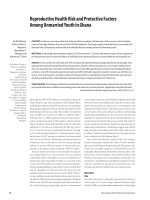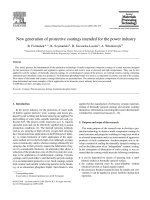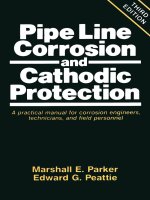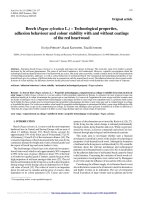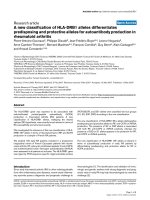CORROSION AND PROTECTIVE COATINGS
Bạn đang xem bản rút gọn của tài liệu. Xem và tải ngay bản đầy đủ của tài liệu tại đây (1.55 MB, 58 trang )
CORROSION AND PROTECTIVE
COATINGS
PROTECTION FROM CORROSION
1. Proper selection and designing
2.Cathodic and anodic protection
3.Protective coating
(a ) Metal Coating
(b) Inorganic coating
(c) Organic coating
4. Corrosion Inhibitors
1. Proper selection and designing
Design an equipment by avoiding contact between two dissimilar metals.
Maintaining a larger anodic area of the metal.
Metals should be close in the galvanic series.
2.
Cathodic Protection
In this method, the corroding metal is forced to behave like a cathode.
There are two types of cathodic protection
a. Sacrificial Anodic protection
In this method, the metallic structure which is to be protected from
corrosion is connected to a more anodic metal by a wire so that the
entire corrosion is concentrated on this more active metal. The more
active metal loses
and get corroded and this metal is called
sacrificial anode. Metals commonly employed as sacrificial anode are
Mg, Zn, Al and their alloys.
Sacrificial Anode
Applications
Important applications of sacrificial anodic method include protection of
buried pipe lines, underground cables, marine structures etc.
b. Impressed current cathodic protection
In this method, an impressed current is applied in the opposite direction
to nullify corrosion current so as to convert the corroding metal from
anode to cathode. Impressed current can be derived from a direct current
source like battery. An inert or insoluble electrode like graphite or silica
act as anode to complete the circuit. The surroundings of anode should be
filled with salts and carbon to increased the conductivity.
Applications
This type of cathodic protection has been applied to water coolers,
water tanks, buried oil and water pipes, transmission towers etc. This
type of protection is employed when
1.
Long term protection is needed
2.
Large structures are to be protected
3.
There is a cheap source of electrical
power.
3. Protective coatings
An
important method for protecting a metal from corrosion is to
apply a protective
coating. The protective coatings may be of metal, inorganic or organic. The coated surface
isolates the metal from the corroding medium. The coating applied must be chemically
inert towards the environment.
Metallic Coatings
Metallic coatings are mostly applied on Iron and steel
because
these
are
cheap
and
commonly
used
construction materials. There are two types of metallic
coatings.
i. Anodic coatings
The base metal which is to be protected is coated with a more anodic metal
for eg. Coatings of Zn, Al and Cd steel are anodic because their electrode
potentials are lower than that of the base metal ie. Fe.
ii. Cathodic Coatings
It is obtained by coating a more inert metal having higher electrode
potential. Than the base metal. Eg. Coating of Sn, Cr, Ni on Fe surface.
The coating should be continuous and free from pores and cracks. These
coating metals usually have higher corrosion resistance than the base
metal.
METHODS OF APPLICATION OF METALLIC COATING
1. Hot Dipping
It is used for producing a coating of low melting metal such as Zn, Sn,
Ph, Al etc on relatively higher melting metals such as iron, steel,
copper etc. This is done by immersing the base metal covered by a
layer of molten flux. The flux is used to keep the base metal surface
clean and also to prevent oxidation of the molten metal. Most widely
used hot dipping methods are : (i) galvanization and (ii) tinning
a. Galvanization
It is the process of coating Zn over iron or steel sheet by immersing it
in molten Zn. The procedure involves the following stages.
The iron or steel article is Ist cleaned by pickling with dil H So for 15
2 4
0
– 20 min. at 60 – 90 C in an acid bath. This treatment also removes
any oxide layer present on the surface of the metal. The article is
then washed with water in a washing bath & dried in a drying
chamber.
It is then dipped in a bath of molten Zn kept at 425 – 4350C. The
Surface of the bath is covered with NH4Cl flux to prevent oxide
formation.
The article gets coated with a thin layer of Zn. It is then passed
through a pair of hot rollers to remove excess of Zn and to get uniform
thickness for coating. Then it is annealed at about 650 0C & cooled
slowly. In the case of Zn coating even if the protecting layer has
cracks on it, iron being cathodic does not get corroded.
Applications
This method is widely used for protection of Fe from atmospheric corrosion in
the form of articles like roofing sheets, wires, pipes, nails, screws, tubes etc. It
is to be noted that galvanized utensils should not come in contact with acids.
ii. Tinning
It is an eg. For cathodic coatings. It is the process of coating Sn over Fe or steel
articles by immersing it in molten Sn. The process consists in Ist treating the iron
sheet with dil H So to remove any oxide film. After this it is passed through a bath
2 4
of ZnCl2 flux which helps the molten Sn to adhere to the metal sheet. Next the sheet
passes through palm oil which prevents through a pair of hot rollers to remove excess
of Sn & produce uniform thickness for Sn coating.
Applications
Tinning is widely used for coating steel, Cu and brass sheets which are
used for making containers for storing food studs, oils, kerosene &
packing food materials. Tinned Cu sheets are used for making cooking
utensils & refrigeration equipments.
2. Metal Cladding
In this process, a thick homogeneous layer of coating metal is bonded firmly &
permanently to the base metal on one or both the sides. This method cnhanceds
corrosion resistance. The choice of cladding material depends on the corrosion
resistance required for any particular environment. Nearly all existing corrosion
resisting metals like Ni, Cu, Al, Ag, Pt and alloys like stainless steel, Ni alloys, Cu
alloys can be used as cladding materials. Cladding can be done by different
means.
a. Fusing cladding material over the base metal
b. Welding
c. Rolling sheets of cladding material over
base metal
3.Metal spraying
In this process, the coating metal in the molten state is sprayed on the
previously cleaned base metal with the help of a sprayer. The sprayer
coatings are continuous but somewhat porous a sealer – oil is applied
on such a coating to provide a smooth surface. However, adhesion
strength of metallic spraying is usually lesser that obtained by hot
dipping or electroplating. It is therefore essential to have a cleaned
metal surface. Spraying can be applied by the following two
techniques.
i. Wire – gun method
In this method, the coating metal in the form of thin wire is melted by an
oxy – acetylene flame and vaporized by a blast of compressed air. The
coating metal adheres to the base metal. Al is coated on aircraft steel
parts using this techniques.
Powder – metal method
In this method, the coating metal is supplied in the form of tine powder which is
converted in to a cloud of molten globules by a blower and are adsorbed on the base
metal surface.



